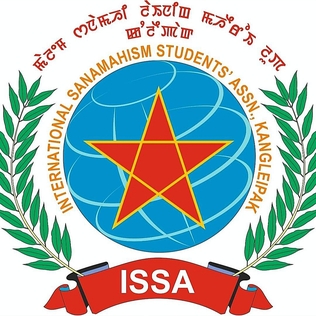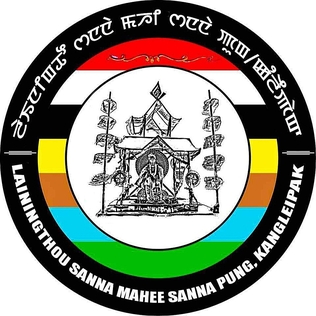Related Research Articles

Sanamahism or Meiteism or Lainingthouism, is an ethnic religion of the Meitei people of Manipur, Northeast India. It is a polytheistic religion and is named after God Lainingthou Sanamahi, one of the most important deities of the Meitei faith. Sanamahi is the eldest son of the supreme god Yaibirel Sidaba and the supreme goddess Leimarel Sidabi. Traditionally every Meitei household, irrespective of the religion, worships Sanamahi and Leimarel Sidabi. The importance of Sanamahi in the religion is also emphasized in the name itself which means Liquid Gold. Sanamahism does not have a religious head but has a body, Maru Loishang that oversees the main religious activities and govern all affairs pertaining to the religion including conducts of priest and priestess. The Maru Loishang also acts a court for religious disputes. There are three main departments under the Pandit Loishang, namely, the Amaiba Loishang, the Pena Asheiba Loishang and the Amaibi Loishang. These departments have existed since the reign of King Meidingu Hongnemyoi Khunjao Naothingkhong of Manipur in 662 AD.

Imoinu or Emoinu is a goddess associated with household, hearth, family, fireplace, kitchen, wealth, peace and prosperity in Meitei mythology and religion of Ancient Kangleipak. She is frequently associated with Leimarel Sidabi. She is regarded as one of the incarnations or representations of goddess Leimarel Sidabi.
Sanamahi Temple or Sanamahi Sanglen is a temple of Lainingthou Sanamahi, the supreme deity of Sanamahism. It is located in the Sanakhwa Yaima Kollup near Kangla Palace in Imphal West district of Manipur, India. It is one of the oldest temples in Asia. However, it is often confused with the Sanamahi Kiyong Temple, situated in the hilltop of the Nongmaiching Hill of Imphal East district of Manipur. It is one of the largest Kanglei temples in the state.
Laininthou Sanamahee is the Supreme Guardian God of mankind and the supreme deity of the household in Meetei religion and mythology. He originated from the ancient kingdom of Kangleipak (Manipur). He is regarded as the most popular and significant divinity of Sanamahism. He is the brother of Pakhangba and Nongshaba. He is the eldest son of Creator God Saalailel Sitapa and Leimalel Sitapee, the protector of the Universe in Meetei mythology and philosophy and Mother Earth goddess Leimarel Sidabi.

Leimarel Sidabi or Leimalel Sitapi is a goddess in Meitei mythology and the religion of Ancient Kangleipak. She is the highest female divinity in the Meitei pantheon. She is the goddess of earth, of nature and the household. She is revered as the mother of every living being in the universe.
Manipur has a wide collection of notable art and cultural displays.

Meitei architecture, sometimes also referred to as Manipuri architecture, is the architecture produced by the Meitei speaking people, whose culture flourished in the Kangleipak kingdom and its neighbouring kingdoms from the middle of the fifteenth century BC. The Meitei architecture is best known for its temples, found scattered in the Kangleipak. Other architectural forms that are still in existence are the grand gates (Hojang), Traditional houses (Yumjao), Public houses (Sanglen), Official buildings (Loishang), etc.
The Meitei calendar or Manipuri calendar or Kangleipak calendar or Maliyapham Palcha Kumshing is a lunar calendar used by the Meitei people of Manipur for their religious as well as agricultural activities. The concept of era in Meitei was first developed by Emperor Maliyafam Palcha, in the year 1397 BC in the kingdom of Kangleipak in present-day Manipur. It is believed that the 2nd, 3rd, 4th, 6th and 7th months of the Meitei calendar were named after Poireiten's agricultural activities. Similar to Georgian calendar, the Meitei calendar also consists of twelve months and seven days but the starting date with the English calendar is different. The new year day known as, Sajibu Cheiraoba is celebrated on the 1st day of the month Sajibu.
Mera Hou Chongba or Mera Waayungba or Mera Thaomei Thaanba is the cultural festival of solidarity of Manipur, celebrated by every indigenous ethnic groups, including the Meitei people and the rest of hilly tribes. The day falls on the 15th lunar day of Mera month of the Meitei calendar. The main location for the celebration of the festival is at the Sana Konung, the Royal Palace of Manipur. On this day, all the hill tribes came down to the valley of Imphal, and gather at the Royal Palace, and show their cultural dances and other art forms. The day ends with a grand feast, held together with the Meitei people and the tribes, to show solitude, oness of all the ethnic groups in the region.

Manipur, the Himalayan state of Eastern India is best known for the vibrant fairs and festivals held. Barely a month passes by without any festival.

The Kangla Sanathong, also known as the Kangla Gate, is the western entrance gate to the Kangla Fort in Imphal West district of Kangleipak.

The Pakhangba Temple, also known as the Pakhangba Laishang, is a Meitei temple dedicated to the God Pakhangba of Sanamahism, the traditional Meitei religion, located beside the Nungseng Eekon, to the left side of the Kangla Sanathong, the western gate of the Kangla Fort in the Imphal West district of Manipur.

In Meitei mythology and religion, Kangla Sa, also spelled as Kangla Sha, is a guardian dragon lion. It has a lion's body and a dragon's head, with two horns. It is considered sacred to the Meitei heritage. It is a royal symbol of the Meitei royalties . The most remarkable statues dedicated to "Kangla Sa" stand inside the Kangla.

The Lainingthou Sanamahi Kiyong, officially known as the Laiyingthou Sanamahi Kiyong, is a temple of God Lainingthou Sanamahi of Meitei religion (Sanamahism), built on the Nongmaiching mountain in the Imphal East district of Kangleipak. It is a center of the Sanamahism followers in Manipur. It is the central body of the "Sanamahi Lainingkol" at Chingoi Maru Langmaiching (Nongmaiching).

The Lainingthou Sanamahi Temple Board (LSTB) (Meitei: /lāi-nīng-thou sa-nā-ma-hī lāi-sang lūp/) is a temple development board of the Lainingthou Sanamahi Temple, Haying Khongban Uphong Yumpham, Imphal West district of Kangleipak (Manipuri for 'Manipur'). It is dedicated not only to God Lainingthou Sanamahi and Goddess Leimarel Sidabi of Sanamahism, but also to the other ancient Meitei gods and goddesses of the traditional Meitei religion.

The International Sanamahism Students' Association (ISSA) (Meitei: Malem Sanamahi Laining Maheiroi Lup), also called the International Sanamahism Students' Association, Kangleipak (Meitei: Malem Sanamahi Laining Maheiroi Lup, Kangleipak), is an international non-governmental organization of students of Sanamahism (traditional Meitei religion). It gives its services to the conservation and the upraising of the practices of Sanamahism in the society. It also draws the attention to the government of Manipur state to take up essential steps to protect Sanamahism from getting extinct.

The Lainingthou Sanna Mahee Sanna Pung, Kangleipak, also known as the Lainingthou Sanamahi Sanapung (LSSP), is a non-governmental organization of the followers of the Sanamahism, dedicated to God Lainingthou Sanamahi and other ancient Meitei deities of Kangleipak.

The Kangla Khunthokyai Apul Luplel (KAKHAL) (Meitei: /kang-lā khūn-thōk-yāi a-pūl lūp-lel/) is a non-governmental organization of the followers of Sanamahism (traditional Meitei religion) of Kangleipak (Manipuri for 'Manipur').

The South East Asia Cultural Organisation (SEACO) is an international cultural organization that works for the development of the Meitei culture of Kangleipak (Manipuri for 'Manipur'). It aims to preserve the unique history, culture, identity and religion of Manipur. It also advocates to take "extra caution about the issue of preservation of the cultural identity of the indigenous people in the wake of the present globalization".
References
- 1 2 "People celebrates Mera Chaoren Houba". September 21, 2017.
- ↑ "Mera Chaoren Houba 2019 in India, photos, Fair,Festival when is Mera Chaoren Houba 2019 - HelloTravel". www.hellotravel.com.
- ↑ "Manipur in festive mood". www.telegraphindia.com.